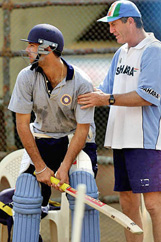COACHING
The Art of Batting - I
- By Polly Umrigar[ A ] GENERAL QUALIFICATION

This man always appears
to have plenty of time
to play his strokes
Batsmanship is an art that consists of timing,
judgment, temperament and concentration.
One hallmark of good batting is that the player appears to have plenty of time in which to play his shots. Some players are marvellous in the nets, but cannot reproduce their form in matches. Others are poor net players, but succeed in matches because they possess the so-called big match temperament.
Hand in hand with temperament must go concentration, which has to be cultivated by anyone who wishes to rise to international standard. Also, he should get into the habit of watching the bowler's hand when the latter is in the act of delivering the ball, and follow the ball in the air, from the pitch till it touches the bat. A batsman should be able to see the ball turning in the air as it comes down the pitch towards him when the bowler is a slow spinner.
Batting at the nets is the first method of improving one's efficiency in batting.
One hallmark of good batting is that the player appears to have plenty of time in which to play his shots. Some players are marvellous in the nets, but cannot reproduce their form in matches. Others are poor net players, but succeed in matches because they possess the so-called big match temperament.
Hand in hand with temperament must go concentration, which has to be cultivated by anyone who wishes to rise to international standard. Also, he should get into the habit of watching the bowler's hand when the latter is in the act of delivering the ball, and follow the ball in the air, from the pitch till it touches the bat. A batsman should be able to see the ball turning in the air as it comes down the pitch towards him when the bowler is a slow spinner.
Batting at the nets is the first method of improving one's efficiency in batting.
Throughout his career, a batsman, even though he may have achieved fame, must practice at the nets. It is always a good idea to try and obtain net practice against the type of bowlers who worry you the most or whom you expect to play in forthcoming matches.
Coaching is necessary for every budding cricketer. However, coaches should always build upon and improve the existing talent. It is seldom wise to completely alter a player's style or try to mould every player into precisely the same type. Coaches should devote more of their time to things where there should be basic soundness, irrespective of grip, stance, stroke production etc. Footwork is one of the keys to great batsmanship.
[ B ] TAKING GUARD
Every batsman upon arriving at the crease must take guard.There are three common positions
I. Middle stump
II. Leg stump
III. Middle and leg or two legs.
The sole purpose of taking guard is to enable the batsman to judge the direction of the ball relative to his wicket. The batsman marks a line from the popping crease
[ C ] THE GRIP
How to grip a bat depends on the batsman's method. Some batsmen have a low grip, in that they hold the bat low down the handle. Others hold the bat in the middle of the handle, and there are some who have a very high grip. Whatever be the grip, the two hands should be very close to one another - in fact just about touching when the batting gloves are on. If the right hand is kept far down the handle, then the batsman is likely to have good defensive control and will be able to play strokes behind the wicket splendidly, but his driving will not bew up to the mark. If the two hands are kept very high up on the handle, then the batsman will have a high back lift and will be able to drive the ball with power. However, he will always be prone to snick the ball in the slips. It is therefore, always advisable to keep the two hands in the 'medium' position for maximum power and control.[ D ] THE STANCE
Once again, we cannot lay down any hard and fast rules because test players have been successful with quite different stances. However, the initial position when awaiting delivery of the ball should be one wherein the batsman is comfortably relaxed and well balanced, so that he is able to go forward or backwards, or attack or defend with equal readiness. One should not crouch right over or stand completely erect.
John wright, coach of the indian team, works on
yuvraj singh's stance Somebatsmen
1: keep a gap of about 6" apart.
2: keep their feet together The rear foot should be atleast a couple of inches behind the batting crease.
This is to allow for a slight drag when playing forward. Remember, the foot must be behind the crease to avoid a stumping. On the line is out.
A stance is of three types. The type varies with the direction in which the front toe points:
1: Towards Gully
2: Towards Cover point
3: Towards Extra cover
(two-eyed stance)
2: keep their feet together The rear foot should be atleast a couple of inches behind the batting crease.
This is to allow for a slight drag when playing forward. Remember, the foot must be behind the crease to avoid a stumping. On the line is out.
A stance is of three types. The type varies with the direction in which the front toe points:
1: Towards Gully
2: Towards Cover point
3: Towards Extra cover
(two-eyed stance)
To be continued... The Art Of batting - II